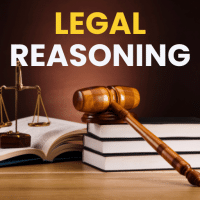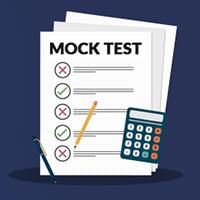CLAT Exam > CLAT Questions > The cost of setting up the type of a magazine...
Start Learning for Free
The cost of setting up the type of a magazine is rs 1000 . The cost of running the printing machine is rs 120 per 100 copies the cost prise of paper ,ink ,and so on is 60 paise per copy .The magazine are sold at rs 2.75 each. 900 copies are printed,but only 784 copies are sold. What is the sum to be obtained feom advertisements to give a profit of10% on cost prize ?
Most Upvoted Answer
The cost of setting up the type of a magazine is rs 1000 . The cost of...
Total cost = type+Printing+paper, ink
= 1000+120*9+540 = 2620;
Net sum to be recovered = Rs. 2882;
Total magazine sold 784 for = 784*2.75 = 2156.
Sum obtained from advertisement = 2882-2156 = Rs. 726
HOPE IT IS
A CORRECT ONE
Community Answer
The cost of setting up the type of a magazine is rs 1000 . The cost of...
Cost Calculation:
The cost of setting up the type of a magazine is rs 1000.
The cost of running the printing machine is rs 120 per 100 copies.
The cost price of paper, ink, and so on is 60 paise per copy.
Number of Copies:
900 copies are printed.
784 copies are sold.
Profit Calculation:
To calculate the profit, we need to determine the total cost and the total revenue.
Total Cost:
The total cost comprises the cost of setting up the type, running the printing machine, and the cost price of paper, ink, etc.
Total cost = Cost of setting up the type + Cost of running the printing machine + Cost price of paper, ink, etc.
Total cost = Rs 1000 + (Rs 120/100 copies * 900 copies) + (0.60 paise/copy * 900 copies)
Total cost = Rs 1000 + Rs 1080 + Rs 540
Total cost = Rs 2620
Total Revenue:
The total revenue is obtained by multiplying the selling price per copy by the number of copies sold.
Total revenue = Selling price per copy * Number of copies sold
Total revenue = Rs 2.75 * 784
Total revenue = Rs 2156
Profit:
Profit is calculated by subtracting the total cost from the total revenue.
Profit = Total revenue - Total cost
Profit = Rs 2156 - Rs 2620
Profit = Rs -464 (Loss)
To achieve a profit of 10% on the cost price, we need to find the sum to be obtained from advertisements.
Sum from Advertisements:
Let's assume the sum to be obtained from advertisements is 'x' rupees.
Profit = 10% of cost price = 10% of Rs 2620 = Rs 262
To cover the loss and achieve a profit of Rs 262, the sum from advertisements should be equal to the loss.
x = Rs 464
Therefore, the sum to be obtained from advertisements to give a profit of 10% on the cost price is Rs 464.
The cost of setting up the type of a magazine is rs 1000.
The cost of running the printing machine is rs 120 per 100 copies.
The cost price of paper, ink, and so on is 60 paise per copy.
Number of Copies:
900 copies are printed.
784 copies are sold.
Profit Calculation:
To calculate the profit, we need to determine the total cost and the total revenue.
Total Cost:
The total cost comprises the cost of setting up the type, running the printing machine, and the cost price of paper, ink, etc.
Total cost = Cost of setting up the type + Cost of running the printing machine + Cost price of paper, ink, etc.
Total cost = Rs 1000 + (Rs 120/100 copies * 900 copies) + (0.60 paise/copy * 900 copies)
Total cost = Rs 1000 + Rs 1080 + Rs 540
Total cost = Rs 2620
Total Revenue:
The total revenue is obtained by multiplying the selling price per copy by the number of copies sold.
Total revenue = Selling price per copy * Number of copies sold
Total revenue = Rs 2.75 * 784
Total revenue = Rs 2156
Profit:
Profit is calculated by subtracting the total cost from the total revenue.
Profit = Total revenue - Total cost
Profit = Rs 2156 - Rs 2620
Profit = Rs -464 (Loss)
To achieve a profit of 10% on the cost price, we need to find the sum to be obtained from advertisements.
Sum from Advertisements:
Let's assume the sum to be obtained from advertisements is 'x' rupees.
Profit = 10% of cost price = 10% of Rs 2620 = Rs 262
To cover the loss and achieve a profit of Rs 262, the sum from advertisements should be equal to the loss.
x = Rs 464
Therefore, the sum to be obtained from advertisements to give a profit of 10% on the cost price is Rs 464.

|
Explore Courses for CLAT exam
|

|
Similar CLAT Doubts
Question Description
The cost of setting up the type of a magazine is rs 1000 . The cost of running the printing machine is rs 120 per 100 copies the cost prise of paper ,ink ,and so on is 60 paise per copy .The magazine are sold at rs 2.75 each. 900 copies are printed,but only 784 copies are sold. What is the sum to be obtained feom advertisements to give a profit of10% on cost prize ? for CLAT 2025 is part of CLAT preparation. The Question and answers have been prepared according to the CLAT exam syllabus. Information about The cost of setting up the type of a magazine is rs 1000 . The cost of running the printing machine is rs 120 per 100 copies the cost prise of paper ,ink ,and so on is 60 paise per copy .The magazine are sold at rs 2.75 each. 900 copies are printed,but only 784 copies are sold. What is the sum to be obtained feom advertisements to give a profit of10% on cost prize ? covers all topics & solutions for CLAT 2025 Exam. Find important definitions, questions, meanings, examples, exercises and tests below for The cost of setting up the type of a magazine is rs 1000 . The cost of running the printing machine is rs 120 per 100 copies the cost prise of paper ,ink ,and so on is 60 paise per copy .The magazine are sold at rs 2.75 each. 900 copies are printed,but only 784 copies are sold. What is the sum to be obtained feom advertisements to give a profit of10% on cost prize ?.
The cost of setting up the type of a magazine is rs 1000 . The cost of running the printing machine is rs 120 per 100 copies the cost prise of paper ,ink ,and so on is 60 paise per copy .The magazine are sold at rs 2.75 each. 900 copies are printed,but only 784 copies are sold. What is the sum to be obtained feom advertisements to give a profit of10% on cost prize ? for CLAT 2025 is part of CLAT preparation. The Question and answers have been prepared according to the CLAT exam syllabus. Information about The cost of setting up the type of a magazine is rs 1000 . The cost of running the printing machine is rs 120 per 100 copies the cost prise of paper ,ink ,and so on is 60 paise per copy .The magazine are sold at rs 2.75 each. 900 copies are printed,but only 784 copies are sold. What is the sum to be obtained feom advertisements to give a profit of10% on cost prize ? covers all topics & solutions for CLAT 2025 Exam. Find important definitions, questions, meanings, examples, exercises and tests below for The cost of setting up the type of a magazine is rs 1000 . The cost of running the printing machine is rs 120 per 100 copies the cost prise of paper ,ink ,and so on is 60 paise per copy .The magazine are sold at rs 2.75 each. 900 copies are printed,but only 784 copies are sold. What is the sum to be obtained feom advertisements to give a profit of10% on cost prize ?.
Solutions for The cost of setting up the type of a magazine is rs 1000 . The cost of running the printing machine is rs 120 per 100 copies the cost prise of paper ,ink ,and so on is 60 paise per copy .The magazine are sold at rs 2.75 each. 900 copies are printed,but only 784 copies are sold. What is the sum to be obtained feom advertisements to give a profit of10% on cost prize ? in English & in Hindi are available as part of our courses for CLAT.
Download more important topics, notes, lectures and mock test series for CLAT Exam by signing up for free.
Here you can find the meaning of The cost of setting up the type of a magazine is rs 1000 . The cost of running the printing machine is rs 120 per 100 copies the cost prise of paper ,ink ,and so on is 60 paise per copy .The magazine are sold at rs 2.75 each. 900 copies are printed,but only 784 copies are sold. What is the sum to be obtained feom advertisements to give a profit of10% on cost prize ? defined & explained in the simplest way possible. Besides giving the explanation of
The cost of setting up the type of a magazine is rs 1000 . The cost of running the printing machine is rs 120 per 100 copies the cost prise of paper ,ink ,and so on is 60 paise per copy .The magazine are sold at rs 2.75 each. 900 copies are printed,but only 784 copies are sold. What is the sum to be obtained feom advertisements to give a profit of10% on cost prize ?, a detailed solution for The cost of setting up the type of a magazine is rs 1000 . The cost of running the printing machine is rs 120 per 100 copies the cost prise of paper ,ink ,and so on is 60 paise per copy .The magazine are sold at rs 2.75 each. 900 copies are printed,but only 784 copies are sold. What is the sum to be obtained feom advertisements to give a profit of10% on cost prize ? has been provided alongside types of The cost of setting up the type of a magazine is rs 1000 . The cost of running the printing machine is rs 120 per 100 copies the cost prise of paper ,ink ,and so on is 60 paise per copy .The magazine are sold at rs 2.75 each. 900 copies are printed,but only 784 copies are sold. What is the sum to be obtained feom advertisements to give a profit of10% on cost prize ? theory, EduRev gives you an
ample number of questions to practice The cost of setting up the type of a magazine is rs 1000 . The cost of running the printing machine is rs 120 per 100 copies the cost prise of paper ,ink ,and so on is 60 paise per copy .The magazine are sold at rs 2.75 each. 900 copies are printed,but only 784 copies are sold. What is the sum to be obtained feom advertisements to give a profit of10% on cost prize ? tests, examples and also practice CLAT tests.

|
Explore Courses for CLAT exam
|

|
Signup to solve all Doubts
Signup to see your scores go up within 7 days! Learn & Practice with 1000+ FREE Notes, Videos & Tests.
























